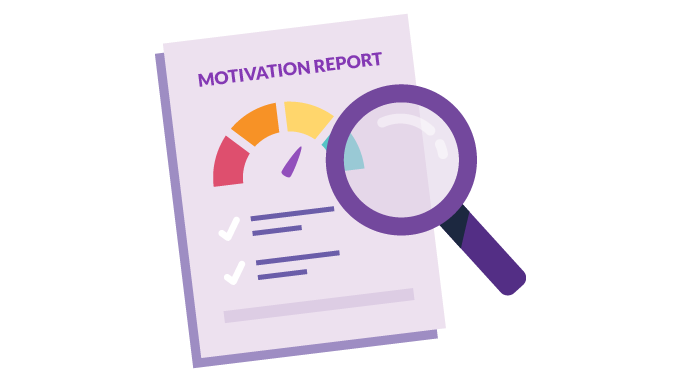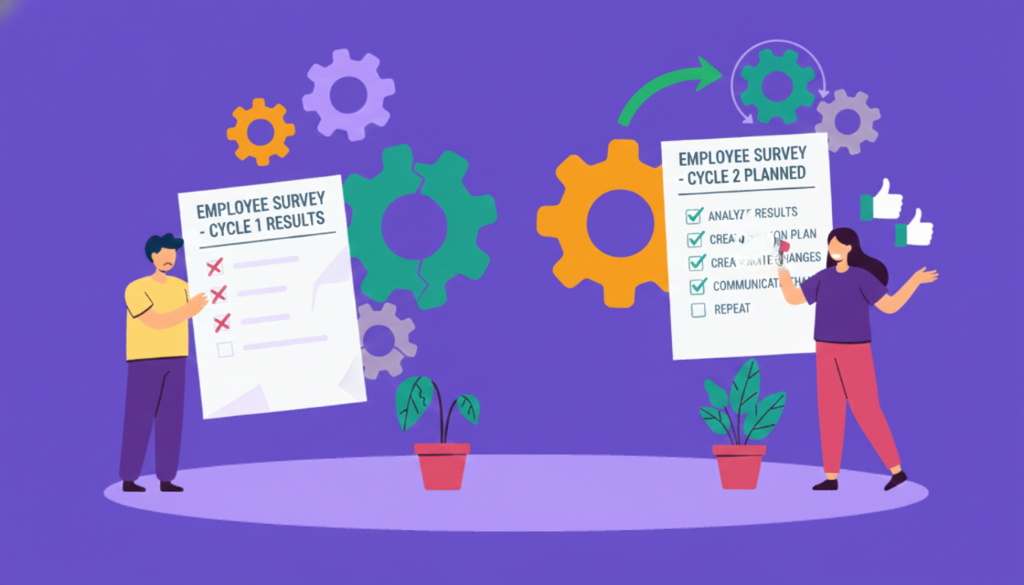Employee Motivation Survey: 50 Essential Questions to Boost Workplace Engagement

A Global Employee Recognition and Wellness Platform
Employee motivation rarely crashes in dramatic fashion; it fades quietly, first into slower project turnaround, then missed ideas in brainstorms, and finally the resignation email nobody saw coming. Latest reports put genuine engagement at just 21 percent, a shortfall big enough to drain trillions from productivity each year.
An employee motivation survey replaces after-the-fact guessing with real-time signals. By asking direct questions about purpose, recognition, growth, compensation, and day-to-day friction, you collect data precise enough to guide quick wins and long-term fixes before another percentage point of energy slips away.
Key Takeaways
- What is an Employee Motivation Survey?
- Internal vs External Motivation
- 50 Employee Motivation Survey Questions
- Why Employee Motivation Surveys Matter?
- Implementation Roadmap
- Common Pitfalls and How to avoid them?
- Conclusion
What Is an Employee Motivation Survey?

An employee motivation survey identifies the factors that motivate individuals to put in discretionary effort using a standardized questionnaire. “How do you feel about the organization?” is a question asked in engagement surveys. The question "What makes you want to do great work today?" is a deeper one in motivation surveys.
“When leaders throughout an organization take an active, genuine interest in the people they manage, when they invest real time to understand employees at a fundamental level, they create a climate for greater morale, loyalty, and, yes, growth.”
– Patrick Lencioni
Why bother?
-
Sharper focus – It measures immediate, actionable drivers of daily energy.
-
Real metrics – Likert, satisfaction, and Net Promoter scales feed straight into KPIs.
-
Flexible cadence – Run a 10-question pulse every quarter or a 50-question deep dive once a year.
Essentially, employee motivation surveys help you understand what drives your workforce, whether it's personal fulfillment, recognition, or the right work environment. By identifying both intrinsic and extrinsic motivators, you can take targeted action to improve engagement, satisfaction, and performance across the organization.
Understanding Motivation: Internal vs. External Drivers
Motivation can come from within or be influenced by external factors. Understanding these drivers allows you to tailor engagement strategies.
Internal (Intrinsic) Motivation
This comes from personal fulfillment, purpose, and growth. Employees motivated by internal factors are driven by:
-
Purpose: Believing their work has a meaningful impact.
-
Autonomy: Having control over their tasks and decisions.
-
Mastery: The desire to learn and improve skills.
-
Challenge: Opportunities to grow through challenging tasks.
External (Extrinsic) Motivation
These are external rewards and the work environment that influence behavior. Examples include:
Recognition: Praise or acknowledgment for a job well done.
Compensation: Fair pay, bonuses, and benefits.
Work Environment: The tools, resources, and culture provided to employees.
Social Connections: Building relationships with colleagues and teams.
By understanding both intrinsic and extrinsic motivators, you can create a well-rounded strategy that boosts employee engagement across the board.
50 Essential Employee Motivation Survey Questions

(Use the question types listed below for consistency in your survey design)
Job Satisfaction & Overall Motivation (10)
-
On a scale of 1–5, how excited are you to start work each day? (Likert scale)
-
I feel motivated to do my best work every day. (Likert scale)
-
My work gives me a sense of personal accomplishment. (Likert scale)
-
How satisfied are you with your current role overall? (1–10 scale)
-
My daily tasks are engaging and challenging. (Agree/Disagree scale)
-
What is your biggest motivation at work right now? (Open-ended)
-
How likely are you to recommend this company as a great place to work? (NPS 0-10 scale)
-
I feel passionate about the work I do here. (Likert scale)
-
My responsibilities align with my interests and skills. (Agree/Disagree scale)
-
What would motivate you to be even more productive at work? (Open-ended)
Leadership & Management (8)
-
My direct manager provides clear, constructive feedback. (Likert scale)
-
I have confidence in decisions made by senior leadership. (Agree/Disagree scale)
-
Management values employees’ opinions. (Likert scale)
-
My supervisor shows genuine interest in my career growth. (Yes/No + explanation)
-
Rate your manager’s leadership style. (Excellent to Poor scale)
-
I’m empowered to make decisions in my role. (Agree/Disagree scale)
-
I receive adequate support when facing challenges. (Likert scale)
-
Senior leadership communicates company goals effectively. (Agree/Disagree scale)
Career Development & Growth (8)
-
I have clear opportunities for professional growth here. (Likert scale)
-
Training programs meet my professional needs. (Agree/Disagree scale)
-
The organization invests in my long-term success. (Likert scale)
-
How satisfied are you with advancement opportunities? (1–10 scale)
-
I have access to mentorship or coaching. (Yes/No)
-
My role lets me develop new skills regularly. (Agree/Disagree scale)
-
I have a clear career path outlined here. (Likert scale)
-
What additional training would help you succeed? (Open-ended)
Recognition & Rewards (7)
-
I feel adequately recognized for my contributions. (Likert scale)
-
Good performance is rewarded fairly in this organization. (Agree/Disagree scale)
-
I’m satisfied with my total compensation package. (Very Satisfied to Very Dissatisfied scale)
-
Recognition from my manager motivates me to perform better. (Agree/Disagree scale)
-
The company’s reward system drives high performance. (Likert scale)
-
How often do you receive recognition? (Multiple choice: Daily, Weekly, Monthly, Rarely, Never)
-
Which type of recognition motivates you most? (Multiple choice: Public praise, monetary rewards, growth opportunities, flexible time, etc.)
Work Environment & Culture (8)
-
I feel safe and comfortable in my workspace. (Agree/Disagree scale)
-
The atmosphere here is positive and supportive. (Likert scale)
-
I have the tools and resources needed to do my job. (Yes/No + explanation)
-
Our company culture aligns with my personal values. (Strongly Agree to Strongly Disagree scale)
-
I feel like I belong on my team. (Likert scale)
-
Teamwork and collaboration are strong here. (Agree/Disagree scale)
-
I’m comfortable expressing opinions at work. (Likert scale)
-
How would you describe our culture? (Open-ended)
Work-Life Balance & Flexibility (5)
-
I can maintain a healthy balance between work and personal life. (Agree/Disagree scale)
-
My workload is reasonable. (Likert scale)
-
The company offers adequate flexibility for personal needs. (Very Satisfied to Very Dissatisfied scale)
-
I feel comfortable taking time off when needed without guilt. (Agree/Disagree scale)
-
How well does the company support remote or flexible schedules? (Excellent to Poor scale)
Communication & Feedback (4)
-
Important information is communicated clearly and on time. (Likert scale)
-
I’m comfortable giving honest feedback to my supervisor. (Agree/Disagree scale)
-
There are adequate opportunities for two-way communication in this organization. (Yes/No)
-
How effective is communication between departments? (Very Effective to Very Ineffective scale)
Why Employee Motivation Surveys Matter?

-
Lower Productivity Loss:
A study found that higher levels of employee motivation are significantly associated with lower self-reported productivity loss. This effect holds even when employees face health or work environment challenges. -
Positive Impact on Task Performance:
Meta-analyses and empirical research confirm that intrinsically motivated employees are more likely to engage deeply with tasks and expend more effort, resulting in superior individual performance and scientific output. -
Lower Turnover Intentions:
Employees who are motivated and satisfied with their jobs are less likely to consider leaving the organization. Motivation is repeatedly identified as a driver of employee loyalty and retention, with empirical studies showing that high motivation reduces both actual turnover and turnover intention. -
Absenteeism Falls:
Research has shown that, when organizations share and act upon survey feedback targeting motivation, groups experience lower incident rates of absenteeism and lost workdays compared to those where feedback is ignored. -
Motivation Surveys Drive Action and Results
When motivation is measured and results are used for targeted action, scientific studies have documented improvements in job satisfaction, commitment, communication, performance feedback, and participatory management—all of which reinforce and amplify motivation.
Adapting the Survey to Your Organization

-
Small businesses (< 50 employees): Ask about direct access to leadership, autonomy, and how wearing multiple hats affects growth.
-
Large enterprises (500 + employees): Probe cross-department collaboration, bureaucracy, and clarity of career paths.
-
Remote or hybrid teams: Explore virtual connection, meeting quality, and home-office support. Compare scores across remote, hybrid, and on-site cohorts.
Implementation Roadmap
Phase 1: Pre-Launch (1-2 Weeks)
-
- Secure leadership buy-in: Ensure leadership understands the importance of the survey and is committed to acting on the results.
-
- Select the right survey platform: Choose a survey tool that fits your needs (easy to use, mobile-responsive, and offers analytics).
-
- Customize the survey: Tailor the 50 questions to your organization’s needs.
-
- Communicate the launch: Inform employees about the survey, its purpose, and confidentiality.
Phase 2: Launch & Collection (2-3 Weeks)
-
Send the survey: Launch the survey with a clear deadline (typically 2 weeks).
-
Send reminders: A gentle reminder after a week and a final reminder just before the deadline can boost response rates.
-
Monitor response rates: Track participation and encourage departments with low response rates to complete the survey.
Phase 3: Analysis (1-2 Weeks)
-
Data cleaning: Review responses for completeness and remove incomplete data.
-
Analyze the data: Identify patterns, strengths, and areas for improvement.
-
Segment the data: Break down results by department, location, and role to pinpoint specific needs.
Phase 4: Action & Follow-Up (Ongoing)
-
Communicate results: Share the findings with employees and announce the action plan.
-
Implement changes: Focus on both quick wins and long-term initiatives based on the survey feedback.
-
Track progress: Conduct a follow-up pulse survey in 3-6 months to measure improvements and refine strategies.
Common Pitfalls and How to Avoid Them
-
The hour-long survey: Survey fatigue and drop-outs spike after 15 minutes. Keep it tight or rotate sections each year.
-
Leading language: Skewed wording ruins data quality. Pilot with a diverse group and rewrite neutrally.
-
No demographic tags: Without department or tenure fields, you can’t target actions. Collect the bare essentials.
-
Launching without an action plan: Nothing kills trust faster. Assign owners and deadlines before you hit “send.”
Conclusion
Motivation fuels the behaviors that drive performance, retention, and culture. A data-driven employee motivation survey gives leaders a clear window into that fuel source, replacing assumptions with facts and next steps. With the 50-question framework, implementation roadmap, and analysis guidance above, you can move from idea to insight in eight weeks. Then the real work begins: acting quickly, communicating transparently, and measuring relentlessly.

















